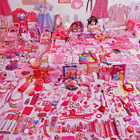 |
| SeoWoo and Her Pink Things
2006 |
|
|
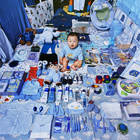 |
| Jake and His Blue Things 2006
|
|
|
| |
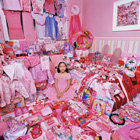 |
| SeoWoo and Her Pink Things2 2008 |
|
|
 |
| Yeachan and His Blue Things 2005
|
|
|
| |
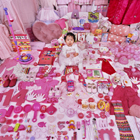 |
| Dayeun and Her Pink Things 2007 |
|
|
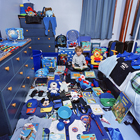 |
| Thomas and His Blue Things 2006
|
|
|
| |
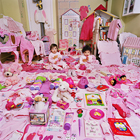 |
| Lauren & Carolyn and Their Pink Things 2006
|
|
|
|
|
| |
 |
| Alexandra and Her Pink Things 2006
|
|
|
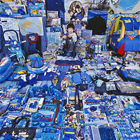 |
| Seunghyuk and His Blue Things 2007
|
|
|
| |
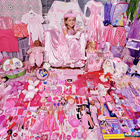 |
| Tess and Her Pink & Purple Things 2006
|
|
|
 |
| Terry and His Blue Things 2005 |
|
|
| |
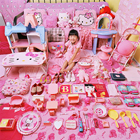 |
| Yealin Yang and Her Pink Things 2005
|
|
|
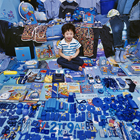 |
| Seyoon and His Blue Things 2007
|
|
|
| |
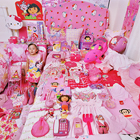 |
| Yealin Ham and Her Pink Things 2005
|
|
|
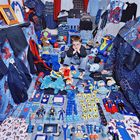 |
| Steve and His Blue Things 2006
|
|
|
| |
 |
| Maia and Her Pink Things 2006
|
|
|
 |
| Kihun and His Blue Things 2007
|
|
|
| |
|
|
|
My current work, The Pink and Blue Projects are the topic of my thesis. This project explores the trends in cultural preferences and
the differences in the tastes of children (and their parents) from diverse cultures, ethnic groups as well as gender socialization and identity.
The work also raises other issues, such as the relationship between gender and consumerism, urbanization, the globalization of consumerism and the new capitalism.
The Pink and Blue Projects were initiated by my five-year-old daughter, who loves the color pink so much that she wanted to wear only pink clothes and play with only pink toys and objects.
I discovered that my daughter’s case was not unusual. In the United States, South Korea and elsewhere, most young girls love pink clothing, accessories and toys.
This phenomenon is widespread among children of various ethnic groups regardless of their cultural backgrounds. Perhaps it is the influence of pervasive commercial
advertisements aimed at little girls and their parents, such as the universally popular Barbie and Hello Kitty merchandise that has developed into a modern trend.
Girls train subconsciously and unconsciously to wear the color pink in order to look feminine.
Pink was once a color associated with masculinity, considered to be a watered down red and held the power associated with that color. In 1914, The Sunday Sentinel,
an American newspaper, advised mothers to “use pink for the boy and blue for the girl, if you are a follower of convention.” The change to pink for girls and
blue for boys happened in America and elsewhere only after World War II. As modern society entered twentieth century
political correctness, the concept of gender equality emerged and, as a result, reversed the perspective on the colors associated with each gender as well as
the superficial connections that attached to them . Today, with the effects of advertising on consumer preferences, these color customs are a worldwide standard.
The saccharine, confectionary pink objects that fill my images of little girls and their accessories reveal a pervasive and culturally manipulated expression of
femininity” and a desire to be seen. To make these images, I arrange and display the cotton - candy colored belongings of several children in their rooms.
When I began producing the pink images, I became aware of the fact that many boys have a lot of blue possessions. Customers are directed to buy blue items for boys and pink for girls.
In the case of my eleven-year-old son, even though he does not seem to particularly like the color blue over other colors, whenever we shop for his clothes,
the clothes he chooses are from the many-hued blue selection. The clothes and toy sections for children are already divided into pinks for girls and blues for boys.
Their accessories and toys follow suit.
The differences between girls’ objects and boys’ objects are also divided and affect their thinking and behavioral patterns. Many toys and books for girls
are pink, purple, or red, and are related to make up, dress up, cooking, and domestic affairs. However, most toys and books for boys are made from the different
shades of blue and ? are related to robots, industry, science, dinosaurs, etc. This is a phenomenon as intense as the Barbie craze. Manufacturers produce
anthropomorphic ponies that have the characteristics of young girls. They have barrettes, combs and accessories, and the girls adorn and make up the ponies.
These kinds of divided guidelines for the two genders deeply affect children’s gender group identification and social learning.
As girls grow older, their taste for pink changes. Until about 2nd grade, they are very obsessed with the color pink, but around 3rd or 4th grade,
they do not obsess with pink as much anymore. Usually, their tastes change to purple. Later, there is another shift. However,
the original association with the color-code often remains.
본 ‘핑크 & 블루 프로젝트'는 핑크색을 너무나 좋아해서, 언제나 핑크색 옷을 입고, 핑크색 장난감만을 사길 원하는 나의 다섯 살 된 딸아이로 인해 처음 시작 되었다. 분홍색만 좋아하는 딸의 취향은 그리 특별한 것이 아니다. 한국과 미국 그리고 어디서나, 많은 어린 여자 어린이들은 핑크색 옷, 액세서리와 장난감들을 너무나 좋아한다. 이러한 현상은 그 어린이들의 문화적 배경이 다름에도 불구하고, 다양한 인종의 어린이들에게 널리 퍼진 현상이다. 이것은 어린 아이들과 그들의 부모들을 겨냥한, 모던 트렌드로 발전한 일반적으로 유명한 바비와 헬로우 키티 등의 제품들과 같은 상업적인 광고의 영향인 것으로 생각했다.
제1차세계대전 이전, 핑크색은 연한 빨간색으로, 한때 사내다움 (남자다움)과 관계 있었던 색깔이었다. 1914년 미국 신문 ‘The Sunday Sentinel' 에서는, 부모들에게 “만약, 당신이 이 시대의 관습을 따르려면, 남자 어린이들에게는 핑크색을, 여자 어린이들에게는 파란색을 사용하도록 하라'고 말하고 있다. 겨우 세계 제2차 세계대전 후에야 비로소 미국과 다른 지역에서, 소녀들을 위해서는 핑크색을, 소년들을 위해서는 파란색을 주는 젠더에 따른 색의 변화가 일어났다. 현대사회가 20세기의 정치적인 올바름에 들어서면서, 젠더에 따른 평등성의 개념이 일어나면서, 그 결과, 그 안의 있던 피상적인 관계뿐만 아니라, 각 젠더에 따른 색깔에 대한 관점의 변화가 역전되었다.
당분이 많아 보이는, 설탕에 절인듯한 핑크색로 가득찬 액세서리과 작은 소녀들로 보여지는 ‘핑크 프로젝트' 이미지들은 만연화되고 문화적으로 조정된 표현인 ‘femininity(여성성)'와 그렇게 보여지기를 원하는 무의식적 욕망의 표현이다. 나는 이 이미지들을 만들기 위해서, 여러 어린이들의 방에서 그 어린이들의 솜사탕 같은 색깔의 물건들을 가지런히 진열했다.
처음 이 핑크 이미지들을 만들기 시작하면서, 한편으로, 많은 남자 어린이들의 경우, 수많은 파란색 물건들을 갖고 있다는 사실을 알게 되었다. 소비자들은 남자 어린이들을 위해서는 파란색 물건들을, 여자 어린이들을 위해서는 핑크 물건들을 사도록 유도된다. 나의 14살 된 아들의 경우, 특별히 파란색이나 다른 색깔을 좋아하지 않아보이는데도 불구하고, 우리가 같이 옷을 사러 갈 때마다, 파란색 계통의 물건들을 사게 된다. 어린이들을 위한 옷과 장난감 섹션은 이미 남자 어린이들을 위해서는 파란색 계통으로, 여자 어린이들을 위해서는 핑크색 계통으로 나눠져 있다. 그들의 액세서리와 장난감은 옷 색깔에 따르는 경우가 많다.
여자 어린이들의 물건들과 남자 어린이들의 물건들은 이미 나눠져 있고, 그들의 사고와 행동패턴에 영향을 미친다. 여자 어린이들을 위한 많은 장난감들과 책들은 핑크색, 보라색 또는 빨간색 계통의 것들이 많고, 대부분, 그것들은 화장, 옷 입는 것, 요리, 그리고 집안 일들과 관계가 있다.
반면, 남자 어린이들을 위한 다양한 농담의 색조로 만들어진 파란색 장난감과 책들은 대부분, 로보트, 산업, 과학적인 것, 공룡 등과 관계가 있다. 이러한 현상은 “바비(Barbie)”에 대한 열광 만큼이나 강렬한 것이다. 심지어, 바비사에서 나오는 작은 포니 장난감들은 어린 소녀들의 특성을 갖고 있다. 그것들은 막대모양의 머리핀, 빗 그리고 악세사리들을 가지고 있고, 소녀들은 그 포니들을 치장하고, 화장시킨다. 이처럼 두 젠더에 따라 나뉘어진 가이드라인은 어린이들의 성 정체성과 사회성 체득 등에 깊게 영향을 미친다.
여자 어린이들은 나이가 들어가면서 핑크색에 대한 취향이 변하기 시작한다. 약 2학년 정도까지는 핑크색에 완전히 중독된 어린이들이 많다. 그러나, 3학년, 4학년으로 올라갈수록 그들은 더 이상 핑크색을 그 전처럼 강박적으로 좋아하지 않는다. 많은 어린이들의 경우, 그들의 취향은 보라색이나 하늘색으로 변하는 경우가 많고, 점점, 다른 색깔을 좋아하는 것으로 색깔에 대한 선호가 바뀌기 시작한다. 하지만, 여전히 근본적인 젠더에 따른 칼라코드의 잔재는 남아있다.
윤정미, <핑크 & 블루 프로젝트> 중에서 |